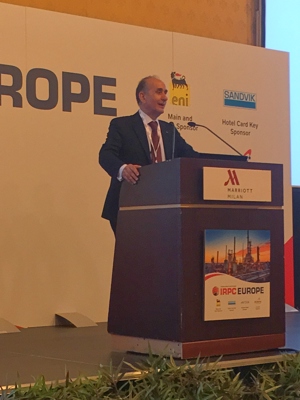IRPC Europe: The great challenges—sustainability, decarbonization, and new regulations
Giacomo Rispoli, Executive Vice President Portfolio Management, Eni, provided the keynote address during the opening day of Hydrocarbon Processing’s International Refining and Petrochemical Conference (IRPC) Europe in Milan, Italy. Mr. Rispoli provided details on three great challenges taking place within the refining industry: sustainability, decarbonization, and new regulations. “There are tough, but important years ahead for the refining industry,” said Mr. Rispoli “that will be shaped by inevitable forces like climate change, decarbonization, and sustainability.”

Regarding sustainability, Mr. Rispoli noted that the great challenge of the 21st century is to combine the planet’s growing energy needs and the need to progressively reduce greenhouse gas (
The company is also focusing their efforts on a more sustainable transportation sector. “The challenge of combining growth with GHG emissions reduction is even more important in the transport sector as mobility is continuously increasing as the world becomes more interconnected,” said Mr. Rispoli. He went on to say that the transition to an increasingly sustainable mobility will be gradual and will have to foresee all the available solutions. The adoption will have to involve new technologies. “The achievement/solutions of this objective,” said Mr. Rispoli “will be done by different models of individual and collective mobility, new transport infrastructure, increasing the use of biofuels, the further development of traction systems, new energy carriers, carbon dioxide capture and reuse, recycling, and the circular economy.” At present, Eni is utilizing its novel Ecofining technology to produce green diesel (e.g. Eni Diesel +). According to Eni’s website, green diesel, such as Eni Diesel+ is the first significant step towards complying with strict biofuels legislation in Europe.
New regulations add to the challenges being faced by the refining industry, as well. One of the most significant regulations is MARPOL’s Global Sulfur Cap, which calls for a reduction in sulfur content in marine fuels from 3.5% to 0.5%. This new regulation will go into effect in 2020. This initiative will affect more than 50,000 ships worldwide. One of the ways marine vessels can adhere to the new policy is to burn low-sulfur-compliant fuels. “There are three pathways to supply marine bunker fuel of 0.5% sulfur,” said Mr. Rispoli “process ultra-low sulfur crude, blend more middle distillates into high-sulfur residue or make major investments in bottom of the barrel conversion plants—but avoiding a dramatic environmental impact.”
Eni has developed a novel approach to meet the new IMO regulation head-on. The company has developed its Eni Slurry Technology (EST). The technology is a hydrocracking-based process with three unique features:
Nano dispersed (slurry)non-ageing catalyst- Homogenous and isothermal slurry bubble column reactor
- Innovative process scheme.






Comments